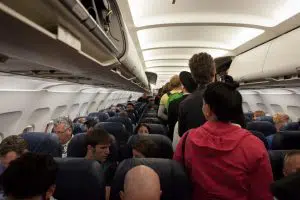If you’ve read my books, you know how important air travel is to many of my storylines. You might also know that FBI Special Agent Kim Otto, the star of my Hunt for Jack Reacher series, doesn’t love flying. She boards the planes and flies because it’s the most efficient way to find Jack Reacher — and do her job. But she believes flying is foolhardy. And sometimes, she’s right!
Agent Otto never sleeps on an airplane. Her theory is that in any airplane disaster, you have a better chance of surviving if you’re awake.
Luckily engine failure is extremely rare due to rigorous safety testing new planes undergo before they fly. You can read more about the testing process in my blog post, The Most Staggering Facts About Plane Safety.
While Otto’s fear of plummeting from the sky is highly unlikely, there are several other potential threats that may wreak havoc on your body while flying.
So what are some of the risks of flying?
- Dry air – The humidity in an airplane’s cabin ranges from about 10-20%. Our bodies function best at around 50% humidity. Dehydration caused by dry air can cause headaches or make you more susceptible to infections. In more extreme cases, dehydration can cause low blood pressure and a rapid heart rate.
- Cabin pressure – Due to cabin pressure, planes have low oxygen levels which can lead to minor oxygen deprivation. As a result, some people may experience lightheadedness, aching joints or shallow breathing. The low cabin pressure can also cause low blood pressure, affecting circulation.
- Extended sitting – Low cabin pressure combined with long periods of sitting in cramped quarters can result in a condition called deep vein thrombosis where blood clots form in the feet or lower legs. These clots may travel up to the heart. Although rare, this condition can have fatal consequences
- Germs – Planes are loaded with germs — sometimes in unexpected places! The water pipes in planes are rarely cleaned and have high levels of bacteria, and in some cases even fecal matter. Yikes! Make sure you use bottled water next time you brush your teeth on a plane.
- Other passengers – New research suggests that the greatest threat to fliers is other passengers. Even people who are not demonstrating any visible symptoms may be contagious. The chances of contracting a cold or flu from a nearby fellow passenger are extremely high.
- Radiation – Flying at high elevations increases risks of radiation exposure. Although the radiation levels are less than that of the X-ray, for frequent fliers this may have an effect on their bodies in the long term.
Despite these threats, you can protect yourself by staying well hydrated, avoiding sugary foods and stretching often while on long flights. Wearing a surgical mask and carrying disinfectant may also help protect you from infected passengers.
To keep up with my books that follow Kim Otto’s Hunt for Jack Reacher and the many dangers that accompany the search, CLICK HERE.







Comments are closed.